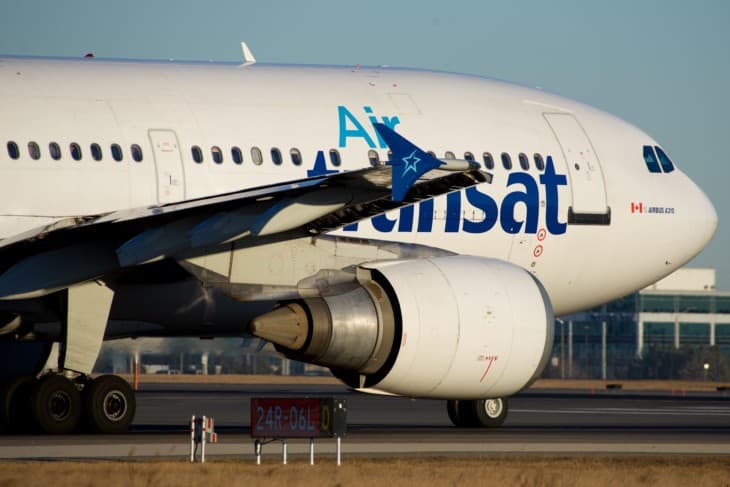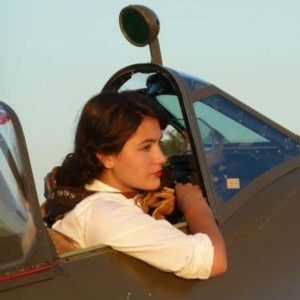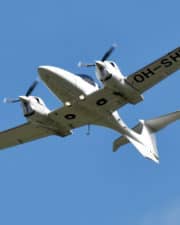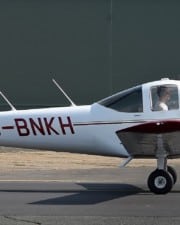Bleed air is a term that is tossed around frequently when it comes to aircraft systems. But what is bleed air exactly and what does it do?
‘Suck, squeeze, bang, blow’: this is the phrase that most people use to describe how an engine works. Known as the Otto cycle, this summarizes the stages of a four-stroke engine that is typically used in a car or a plane. The engine sucks air through the intake, squeezes it through a series of compressors to raise the temperature and pressure before igniting it and producing energy.
What Is Bleed Air?
Bleed air is the name given to the air that is ‘bled’ from the compressor stage of an engine. At this stage the air is around 200-250⁰C and at a medium-high pressure so its energy can be used to power a number of systems, including but not limited to the air conditioning.
Bleed air is used abundantly throughout airliners and helicopters today as it is a readily available source of energy; as long as the engines work, bleed air will be available. Its useful qualities are heat and pressure. Heat is often used for anti-ice and de-icing systems whereas pressure is used for things like cabin air.
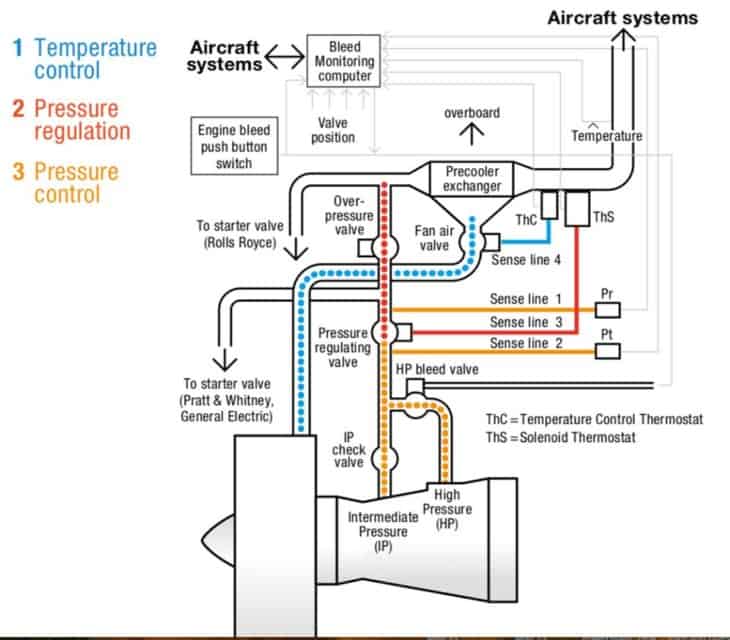
Let’s take a look at what bleed air is used for in airplanes and helicopters.
Anti-Ice
Icing conditions can exist both on the ground and whilst airborne. But with the aid of bleed air, the threat of ice accretion can be mitigated a little.
Icing can occur between +10⁰C and -50⁰C when moisture is present, such as rain or the droplets in a cloud. These droplets can freeze on the cold-soaked wings, changing the shape of the wing and upsetting the lift characteristics designers have so carefully created.
There are numerous ways to rid an aircraft of ice, but bleed air is one of the most commonly used methods.
– Anti Ice via Air Tubes
By re-routing hot bleed air via tubes inside the ‘leading edge’ of the wings, tail surfaces and the engine inlets the surface can be heated to above freezing temperature. Once the warm air raises the temperature of the surface, any ice already formed melts away and further ice accretion is prevented.
This is the most common method of ice protection on big jets. The Boeing 787 is one exception to this. The Dreamliner uses electro-thermal anti-icing for the leading edge of the wings. This is an ice protection system typically seen on lighter aircraft.
As one of the greenest aircraft of its size, the use of electrical instead of bleed air helps to reduce fuel burn and improves overall cost-efficiency by removing the heavy and maintenance-needy bleed systems.
– Anti Ice via De-Icing Boots
Typically, besides climb and descent, jets fly above most ice-prone areas, but for aircraft with lower cruising altitudes, icing is a much more dangerous threat. Turbo-prop aircraft such as the Dash 8 Q400 cruise at altitudes below 27,000ft and spend much more time in the cloud layer.
These aircraft use what is known as ‘pneumatic boots’ to keep their surfaces ice-free. A ‘boot’ is a layer of rubber placed on the leading edge of the wing that is inflated with bleed air to temporarily change the shape of the wing and break off any unwanted ice.
Pneumatic boots haven’t changed all that much since their invention over 80 years ago and are fairly lightweight. Unfortunately they do require regular maintenance. They can crack when exposed to ozone (which is a gas that exists in normal air, but at generally low quantities) and can be subject to punctures if damaged by debris or a bird strike. Lightning may also pose a threat to their integrity.
Check out this video to see how effective they are:
Pressurization & Air Conditioning
Possibly the most important use of bleed air is cabin pressurization. As discussed on one of our other blog posts, pressurizing the air within the cabin allows us to breathe at high altitudes without oxygen masks. So the pressurized air from the engine is a readily available source of pressurized air.
But as already mentioned, bleed air is over 250⁰C when it leaves the engine so it must be cooled via an air-to-air heat exchanger before it can be circulated. This uses cold air from outside the plane and passes it over the hot bleed air until the desired temperature is reached.
The temperature is controlled from the flight deck, although many aircraft have the capability to alter the temperature from inside the cabin. The temperature selector changes the amount of cool air allowed through the air ducts until a desired temperature is reached.
Both engines are used to supply conditioned air, although other sources of bleed are available at various stages of flight. On the ground, many airports in hot locations provide bleed air through a big yellow pipe when parked on stand. This provides the aircraft with air conditioning without the need for us to use the noisy APU.
The auxiliary power unit (APU) is more commonly used however, as external bleed air is not always available. Located at the rear of the aircraft, the APU is essentially a small engine and works in the same way as the larger engines, creates its own bleed air. With the engines switched off this is the source of the air conditioning.
Depressurization
Failures of the bleed air system can lead to cabin depressurization such as on one A319 flight from Cape Town to Johannesburg on 7th September 2008. The crew received a failure warning of the engine 1 bleed system and took the appropriate corrective actions. Nonetheless the cabin altitude began to increase.
The crew then had to make an emergency descent according to their standard procedures until they reached a safe altitude. At this lower altitude they were then able to start the APU and use it as a source of bleed air to restore cabin pressurization, allowing them to continue to their destination.
Hydraulic System Reservoir Pressurization
Bleed air is also useful in conjunction with the hydraulic system. By pressurizing the hydraulic reservoirs, manufacturers are able to prevent cavitation and the damage it causes. Cavitation occurs when the fluid volume demand is greater than the amount of fluid being supplied, leading to bubbles.
They might sound cute, but bubbles in the hydraulic systems are very serious and can cause major failures of pumps and motors. Due to low pressure, the bubbles formed can boil and implode eroding and causing damage to nearby surfaces.
To prevent this, the reservoirs are pressurized with bleed air to eradicate the presence of bubbles within the fluid.
Engine Start
Turbofan engines are usually started on the pushback, prior to taxi and can take 2-3 minutes or more. In order to start the engine in this way the aircraft must have an operational APU supplying both electricity and bleed air.
When the start sequence is initiated, bleed air is sent from the APU to the accessory gear box which rotates the various shafts within the engine. This is when the ‘suck-squeeze-bag-blow’ sequence begins. Once the combustion stage (Bang) within the engine becomes self-sustaining the igniters are switched off and engine start is complete.
Once both engines are started, the APU can then be switched off as it is no longer needed as a source of bleed air. But if the APU is unserviceable, the air must be provided externally from a unit on the ground.
Air is provided to the aircraft via the ‘non-starting’ engine. This allows pressurized air into the system to begin the necessary rotation for engine start. Once this first engine is running, the aircraft once again has an onboard source of bleed air which can be used to start the second engine. This is known as a ‘cross-bleed’ start.
Helicopters – Engine Air Particle Separators
Helicopters use bleed air for the same purpose as planes albeit with the addition of Engine Air Particle Separators (EAPS).
Foreign Object Damage or FOD is a very real threat to aircraft of all kinds, but particularly to helicopters. Over time tiny particles such as dirt or sand can accumulate within the engine. This increases the wear on the engine, degrading it’s performance and ultimately causing the component to fail.
As well as eroding compressor blades, oil blockages and internal sump fires, the intake of huge amounts of dust will eventually lead to the cockpit, contaminating the air and causing avionics failures. This can cause considerable problems in sand-abundant locations, such as Egypt, Hawaii and even Texas.
Without a system to prevent FOD, engine replacements were needed with alarming regularity. In Texas the US Army recorded the average flight time between major overhauls of helicopter engines was 262 hours versus the intended 1200 hours. That’s 2% of the flight time they were expected to reach!
EAPS helps to limit FOD ingestion and extends the life of the engine, allowing helicopters to operate in sandy and dusty areas which had previously caused rapid degradation of components. By installing EAPS they were able to get 6x the lifespan from the engines
To prevent FOD entering the engine, bleed air is used to move the air radially, introducing a centrifugal force to the intake air and pushing the heavier particles such as sand, dirt and even ice outwards, away from the engine.
Problems with Bleed Air
As you would expect, there are various hazards associated with the use of extremely hot and high pressure air…
Fumes
One pitfall of the bleed air/cabin air system is that any contaminants could be potentially circulated around the cabin. For instance, occasionally hot oil may leak from inside the engine. This ‘pyrolized’ oil can then mix with the air being fed to the cabin, leading to a burning smell or toxic smoke entering the cabin if the seals have deteriorated.
Additionally if the engines have been incorrectly washed, residue from the toxic cleaner used can cause similar events. As always, crews are trained to deal with these scenarios appropriately to ensure the safety of the crew and passengers but fumes events such as these have raised concerns about the quality of cabin air and the long-term effects it might have on the health of aircrew.
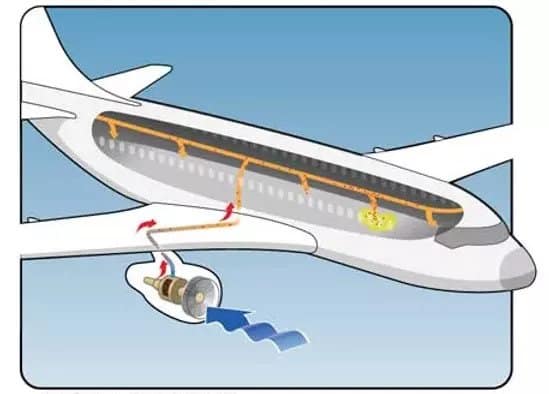
Thankfully these incidents are much less frequent on newer aircraft due to new technology such as HEPA filters. These filters use layers of glass and activated carbon-based material to remove 99.7% of particles within the air, including harmful microbes such as COVID-19.
These filters are what makes flying safe. Unfortunately the absence of these in aircraft such as the B747 is what ultimately led to its early retirement for many operators.
References ▾
- https://www.aviationpros.com/aircraft/business-general-aviation/article/12341137/deice-boot-maintenance-101-the-why-and-how-of-pneumatic-deice-boot-care-and-repair
- https://www.skybrary.aero/index.php/Aircraft_Bleed_Air_Systems
- https://www.fzt.haw-hamburg.de/pers/Scholz/Aero/AERO_PRE_DLRK2018_SolutionsToContaminatedCabinAir_18-09-05.pdf
Related Posts
